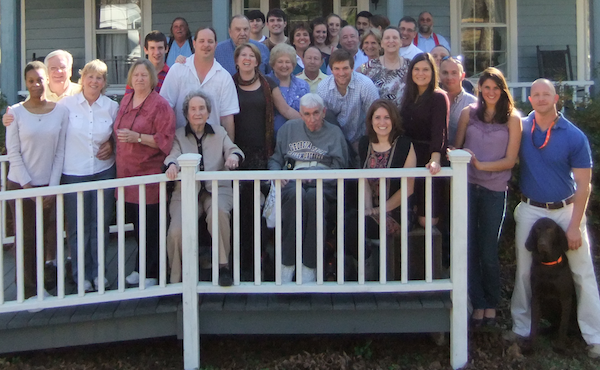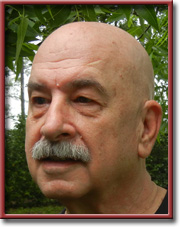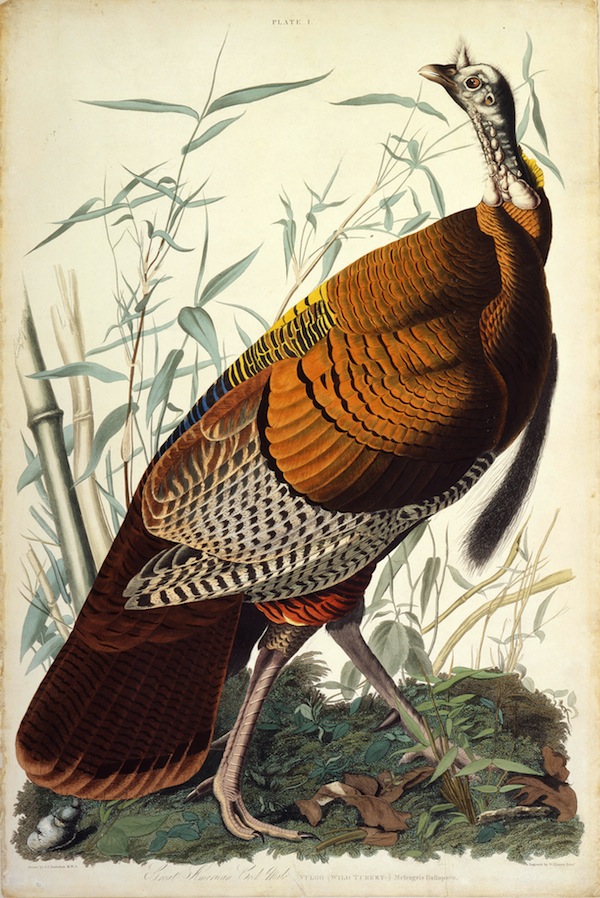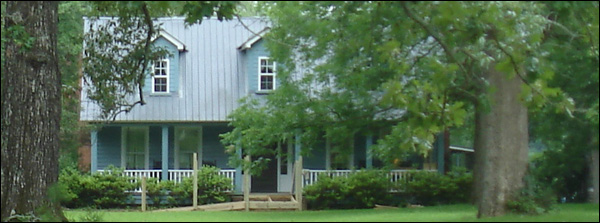A Carolina Midlands Thanksgiving
And the Earth Shall Provide: A Carolina Midlands Thanksgiving
Epicurus’ Porch
By William A. Balk, Jr.

“Despite occasional diversions into the realm of experimentation (nb: deep-frying 15-pound turkeys in hot oil is a questionable practice in or near a home constructed of heart pine—known as ‘pine lighter’), we have maintained the cooking methods perfected by my father after many years of practice and tasting.”—William A. Balk, Jr.
 BEAUFORT South Carolina—(Weekly Hubris)—11/25/2013—The regular morning parade of our resident flock of wild turkey proceeded as usual that morning. It takes the birds about 20 minutes to cross the field next to the home place, on their way to the lower, wetter pine woods. Before reaching the woods’ edge, they must cross an open area of an acre or two of mown grass adjacent the old barn. This time, two toms seized the clear field for a major prance-off. Loud gobbles accompanied magnificent, strutting displays; their huge tail fans unfolding and folding; tilting left and right. Both fluffed themselves up to an impossible size.
BEAUFORT South Carolina—(Weekly Hubris)—11/25/2013—The regular morning parade of our resident flock of wild turkey proceeded as usual that morning. It takes the birds about 20 minutes to cross the field next to the home place, on their way to the lower, wetter pine woods. Before reaching the woods’ edge, they must cross an open area of an acre or two of mown grass adjacent the old barn. This time, two toms seized the clear field for a major prance-off. Loud gobbles accompanied magnificent, strutting displays; their huge tail fans unfolding and folding; tilting left and right. Both fluffed themselves up to an impossible size.
The hens, of course, ignored them completely, undeterred in their pressing quest for luscious, filling bugs.
Meanwhile, a third tom, somewhat larger, approached from the big field, strolling along the edge closest to our house; among the pines in the windbreak. Closely watching the two young toms displaying some 50 feet away, but appearing completely insouciant, he carefully maneuvered among the brightening shadows, nibbling the odd insect. When he came upon a narrow shaft of brilliant, slanting sunlight (dawn was breaking among the pines), he stopped as if he had found his mark, center-stage, in the midst of his spotlight. His dun coloring suddenly became electric, iridescent, brilliant with reds, golds, blues and greens.
Then, slowly and magnificently, he puffed up his feathers, spread his huge pinions, raised his head high—and stood on his spindly toes, flapping those powerful wings. Still in dawn’s intense spotlight, he lowered himself, puffed up to his mightiest proportions, and opened his great feathered fan—just briefly—all shining brass and copper, turning and twisting his feathers for shimmering effect.
Folding himself up again and continuing on into mottled shadow, he revealed no interest at all in the other two, supporting-cast toms, who had just earlier posed so pompously. Now, though, those two had quietly reduced themselves in size; gone silent and meek; and focused, once more, on grazing for bugs. All—the hens, the two young toms, and the Sun King—then continued their slow and royal progress down to the creek.

Benjamin Franklin, of course, knew well the regal character of the North American turkey, Meleagrisgallopavo, and famously championed its selection as the national symbol of the new American nation. He claimed the turkey was far nobler and refined a bird than the favored eagle.
Often, and during much of the year, one of the great flocks of turkeys which reside on the wooded acres of our family’s inland farm will decide to take a different route to their feeding grounds and will cross the mown grass yard before the old farmhouse to see if there is anything of interest among the centipede-grass lawns, the mulched areas under the huge old trees, and the old leaning grape arbors of muscadine and scuppernong.
As it happens, last fall they were to be the beneficiaries of one of my obsessions. I am trying slowly to reduce the portion of the grassy lawn which requires mowing, an area which comprises about five acres around the house. One of the ways I’ve done this is to lay out large areas beneath the great oaks, hickories, sweet gums, and cedars—areas which I cover in a layer of leaf mulch. Even after sweeping the lawns clear of fallen leaves and carefully raking them into these new mulched areas, I find I need much, much more leaf mulch. So, every time I see them, I happily load up the back of my pick-up with bags of leaves left by the curbside. Last fall, I gratefully accepted huge bags offered by my brother-in-law, and I myself brought in some 55 giant bags from curbside collections around town. I could have used another hundred.
It was only when I began opening the great bags to spread them beneath the trees that I discovered that some contained as many acorns as leaves—pounds and pounds of them. Out they went, leaves and acorns both, spread to cover the ground.
Shortly after, early on a cool autumn morn, I looked out from the front porch through a heavy morning fog to see a couple dozen turkeys madly scratching away at precisely the spot where I’d just recently dumped the leaves—and acorns. Well, of course, I thought: to them, this is like rib-eye steak, the rich mast from the season’s seed crop. Fattening up on these acorns will provide them strength and endurance for the winter ahead.
The turkeys took little notice of me, even though I was within yards of them. Notoriously skittish, this morning flock decided the acorn bounty trumped any possible threat from me; so they happily scratched away, uncovering more and more morsels. Of course, the toms kept vigil, but no “Flee!” call was uttered, and they consumed their fill while I watched. Eventually, they crossed the road, headed into the woods and the creek bottom, marching off on their daily parade.
Later in the day, I went over to the area where they’d been feeding. The carefully spread leaf mulch had been scattered wildly, and—while there was ample supply of acorns still there—the amount which had been consumed amazed me: reason to hope for a good survival rate through the winter, I thought, and an even larger flock next spring.

Few of us in the family do much hunting, although the abundance of wildlife on this farm and its surrounding acreage does indeed make for impressive “harvesting” for those regular hunters in our area. White-tailed deer make up most of the game hereabouts, and they have become as over-populated here as in most other parts of the country. One difference is that readily available forage in the Midlands enables them to reach a larger size than in many other areas, despite their large numbers.
Hunting does produce some game for our own larder. Two of my mother’s grandsons enjoy hunting on the land, although very little meat ever comes from their efforts. One of these grandsons, on his first hunting foray as a youngster, managed to kill two deer with one shot for his initiation into this traditional father-son ritual. That feat has never been repeated here.
We do let one gentleman not of our family, an old friend of my father’s, hunt the land; this certainly cuts down a bit on the deer-crowding problem but, more important, it helps keep less disciplined and less careful hunters from using the land for their own purposes. As an additional benefit, there’s always the venison we get for the freezer each season.
Our Thanksgiving crowd is a hungry one, and this year we will stick with the traditions years of hosting the big gathering of family and friends have virtually codified. What began many decades ago as an effort to reverse the inevitable drift apart among the four brothers on my father’s side, the Thanksgiving celebration and other gatherings here at the old farm established new traditions to replace older ones that had fallen into disuse. The yearly feasts have gathered together two dozen guests some years, more than three dozen in others, and we serve at big tables set up around the house and on the wrap-around porch.
The dining room, whose wall boards and ceiling boards are twelve inches wide, sawn and hand-planed from trees felled on this land nearly two centuries ago, seats 14 at the big oak table. We seat another ten at the kitchen table, and the big screen-enclosed back porch, which opens onto the dining room, holds another dozen. This is an old farm house, of course; not a fancy showplace. The farmers who built this place and who added on to its humble two-room, log-built beginnings had to accommodate similar gatherings, and the old fireplaces often provided the only source of warmth and fire for cooking.
Our turkeys for Thanksgiving are not, of course, the wild fowl from the woods around us, but we do prepare three big birds for the occasion. Despite occasional diversions into the realm of experimentation (nb: deep frying 15-pound turkeys in hot oil is a questionable practice in or near a home constructed of heart pine—known as “pine lighter”), we have maintained the cooking methods perfected by my father after many years of practice and tasting. We use our smoker-cookers, gas-fired in our case for consistent heat during the cooking, and we maintain a bowl of fragrant flavoring liquid—turkey stock, water, apple juice, spices, whatever—underneath each bird to catch the drippings. We don’t actually smoke the birds, but the salt-based dry rub that coats the birds for two days prior to cooking acts as both marinade and brine. The birds come out richly browned and sumptuously juicy, and the slow, moist cooking high above the heat source keeps both light and dark meat from overcooking.
Old-fashioned Angel Biscuits are a necessary part of the meal, as well. These are hybrid yeast/soda-leavened biscuits, half way between a roll and a biscuit, and buttery and yeasty and light and flaky all at once. We usually need six or seven dozen for the crowd, and if a rare leftover Angel Biscuit or two were ever to be found (or pocketed), it toasts beautifully when split.
We try to have some leftover turkey; hence the three birds. Although leftovers don’t always work out, the delicious sliced meat will go into turkey sandwiches (made with my incomparable wheat-and-oatmeal bread) for guests to take home with them. Most have a drive of several hours ahead after dinner, and I know several will have consumed their turkey sandwiches before arriving home that evening.
Some guests linger around the kitchen table till dusk, having another beer or sipping some Armagnac. The coffee drinkers will finish off the apple pie my cousin always makes, and everyone will agree that the turkey was the best yet. Those traditions—especially praise for the cooks—are among the old ones we keep to make our new traditions part of a long history and to tie the familial bonds just a bit tighter than our modern lives normally permit.
As generations change and the family spreads farther afield, the possibility of actual return to a home place becomes at once an event rarer and more cherished. We hope we can keep that reality alive for those who will follow after and beyond us.
For the bounty we share each Thanksgiving, for the welcome gathering that defines this celebration, and for the opportunity to continue these memories and these gatherings for our progeny and our friends, we are indeed grateful. For those who came before and who join us now solely in memory and tradition, we are fully as grateful. For all our blessings, singular and shared, we are grateful.

Note: The second image used to illustrate this column derives from: http://upload.wikimedia.org/wikipedia/commons/1/1c/John_James_Audubon_-_Great_American_Cock_%28Wild_Turkey%29.jpg.

12 Comments
Mary Laura Jones
Your writing brings me great joy. Thank you for this reflection. It is awesome. My husband and I have a farm in Michigan and the wild turkeys love to mess up the beautiful snow blanket in the winter when we only get there on weekends.
I am hoping to call you sometime after Thanksgiving Day. Will you give me your phone number again and email? I am so looking forward to talking with you.
All best, Mary Laura
My email is mljones2022@gmail.com and 773 636-2022.
Will
Thanks, Mary Laura. It sounds like wonderful turkey habitat there as well….
Anne Roberts
Will –
Full of wonder and warmth, what a beautiful read just before facing the airline hassle for our family reunion in Philadelphia this year. It is more of a citified scene there but none the less full of traditions — the stuffing and Mom’s creamed mushrooms — so many blessings and such fine remembrances. As always Will, thanks for the reminder of how truly splendid is this day of thanksgiving.
Will
A glorious family gathering for you all, Anne. Keep warm!
Linda Christine
Talked to my dear friend, Gloria Farmer for our almost hourly talk last night and she was telling me all about family coming, cooking and with colder weather where everyone would eat…Big families are special and now so many are scattered so it is so heart warming to hear of you and Jenks talk about the old homeplace…Happy Thanksgiving and enjoy your true stories.
Will
Linda, I can’t imagine any conversation more rewarding than one with Miss Gloria. I admire your friendship together. And you are so right, the chance to have the large family gathering at the old homeplace is so rare and so special…we are absolutely fortunate in the extreme. Thank you for your very kind comments.
Jane Balk Ferko
Ah Will, with the exception of a few, this will be my 47th Balk Thanksgiving at the family home of your beautiful parents and with this raucous, spirited, devoted family. Thank you for taking me in when I married your late Uncle Tom and even keeping me when, after his death, I married my dear George. Not only that, but being so gracious to George and making him feel so welcome. It will be sad without him this year, as every day has been since he died in April, but your support and that of your family this year have meant the world to me. I can’t wait to hug everyone of you Thursday! Casserole and cranberry sauce and Susan’s pies are practically on the way.
Will
yummmmm!
Deborah Serravalle
Great article, Will. Sounds odd, but you made me homesick for someplace I’ve never been, to spend time with family who are not my own. Happy Thanksgiving from your Canadian friend.
Ann Courmouzis
As always, Will, I enjoyed so much reading your Thanksgiving chronicle – both the bit about the theatrical Toms and your wonderful family. It’s the first year that I didn’t spend this holiday with my family, but your warm description somehow made up for it in some way. I’d love to send you a post that my husband sent me with some very interesting turkey info., if you could share you e-mail address with me (I may have it somewhere, but can’t seem to find it). All the best, Ann
Will
Deborah, thank you so much for that…it’s always a boost when someone actually gets a sense of what it is one is trying to get across. I hope your Canadian home can make you homesick for it, too, when you’re away; and your memories there stay as strong as ours do for us. Thanks again.
Will
Ann, what a delight to hear from you. I’m dying to read George’s post… I’ll email you. You were part of my Thanksgiving thoughts as I ran out of your wonderful olive oil. Time to take my magic bottle to be refilled!